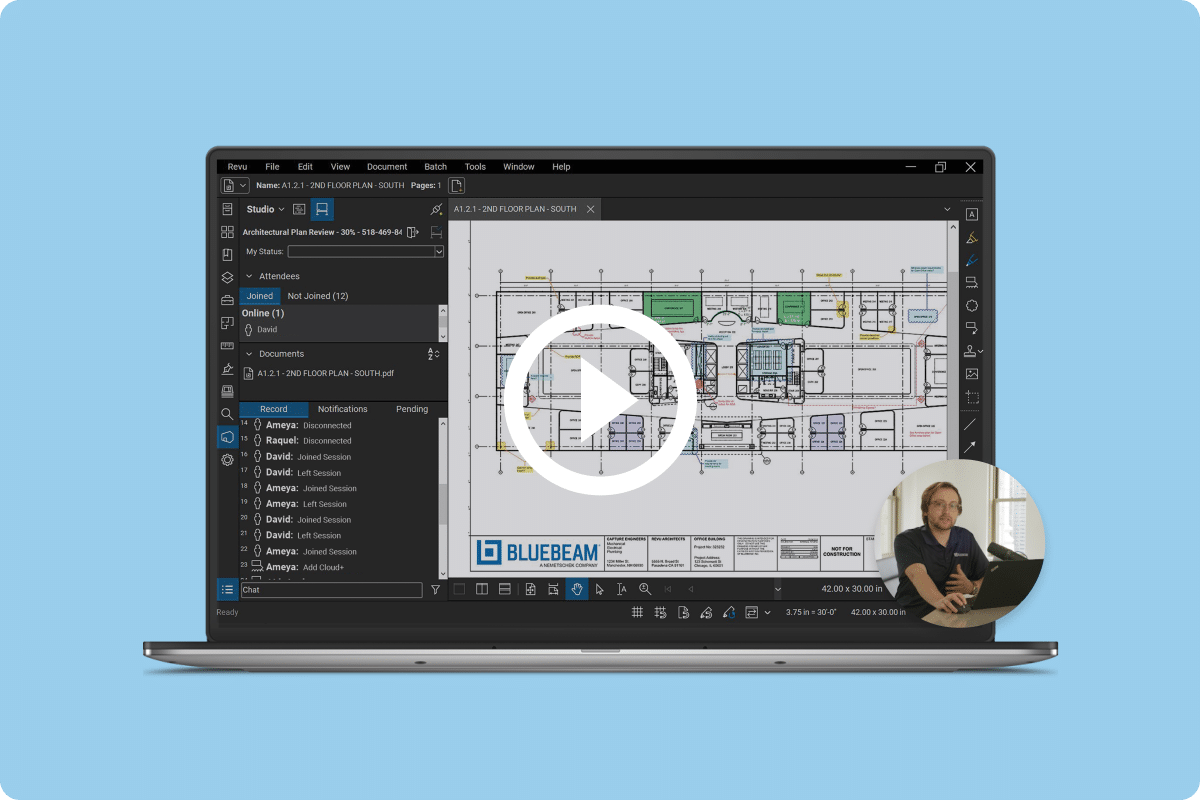Ridge & Partners started using Bluebeam around five years ago to support its QS team with accurate measurement when estimating potential jobs. From this introduction, the use case has been expanded within the business to include document management, design reviews, take-offs, estimations and the final professional handover of documentation to clients.
Nick Barringer is a partner at the firm. He said Bluebeam has transformed the way the business worked. “Our team was introduced to Bluebeam as a tool to make commenting and marking up of drawings more efficient,” he said. “At the time we didn’t see the way that we were doing things as a problem, but immediately saw the benefits once we had been introduced to the software.”
“It was initially used as an internal communication tool for marking up and commenting on drawings and reports,” he continued. “As our understanding of the software’s capability has increased, we are now able to use Bluebeam to produce high-quality sketches to communicate early design stage concepts, alongside detailed markups to assist the on-site construction teams.”

Collating project information
One of the areas where Bluebeam has made a difference is information management. Barringer said: “One of the biggest benefits is that we can easily collate and edit multiple PDF documents in one place. Our old way of working would involve printing, annotating and scanning a large quantity of paper hand markups.”
“Doing this digitally has saved us thousands in paper and printing costs and has made the whole workflow much more efficient in terms of time. It has also facilitated our transition to a truly paper-free office, reducing our environmental impact as a business.”
Rhys Griffiths is an associate at Ridge & Partners and works on the cost management team. He explained that Bluebeam has particularly helped with tender documentation.
“It’s the go-to tool for us. We use it every day, and it helps us to work efficiently and securely. We produce a lot of tender documents and contract documents that all need to be collated and marked up. This can number anywhere from 10 to 100 documents, so we need to be able to work accurately in these files. Bluebeam helps us to send them out in a consistent format that looks professional.”
“It’s the go-to tool for us. We use it every day, and it helps us to work efficiently and securely.”
Rhys Griffiths
Associate
Ridge & Partners
According to Griffiths, one of the primary reasons for investing in the software was to improve the accuracy of measurements. He added: “With Bluebeam it’s very quick if you want to mark up a drawing or measure up an area. A range of in-built functions help with this, including the scaling tools, markups and editing settings, and digital measurement tools including linear, area, polygon and dynamic fill. This saves time and gives us accurate results.”
Replacing the old way of doing things
When companies introduce new software, it can sometimes take time for it to become embedded within the business. Chris Mills is a senior associate at Ridge & Partners and specializes in civils and infrastructure projects. He argues that the efficiency gains with Bluebeam meant that this was not the case.
“When you shift to a new tool, it’s always an interesting process as you adapt,” he said. “A lot of what Bluebeam does aligns with tasks that we already did manually. But the crucial thing is that it’s now about four or five times faster.”
“I used to enjoy working by hand, and I took pride in doing good quality sketches. When I think about how long I used to spend doing that, as well as scanning documents and redoing things when needed, it’s not comparable. Now I can work in real time and it’s so fast. I wouldn’t go back.”
He added that Bluebeam is also useful when working with others to explain concepts and ideas.
“The speed at which we can now produce sketches and drawings means that we can even use it on the fly, which helps if you need to quickly explain a concept to someone,” Mills said. “When doing this on paper, if you make a mistake, you’re either restarting or having to use Tipp-Ex. That feels so last century now.”

Checking for accuracy
Mills also explained how Bluebeam can help maintain accuracy and consistency throughout the project. “We’ll take a snip of the architect section and then draw on top of it and annotate it before sending the information out to the relevant people,” Mills said.
“If we’re reviewing two drawings and we need to see what’s changed, you can use the Overlay and Compare tool, which places the drawings on top of each other and you can clearly see where the colors clash. On one recent project it was invaluable. We had to check hundreds of drawings and see where any changes had occurred, and that function was a game changer.”
“Ordinarily, it would take days to go through that many drawings,” Mills added. “It saved us a huge amount of time.”
“A lot of people would never have thought that it was done in Bluebeam—they’d assume that it had been done in AutoCAD or Revit. It allows us to get information out the door much quicker without having to be proficient in CAD software.”
Alex Hall
Partner
Building services team
Starting with Bluebeam
Alex Hall works in the building services team. He said Bluebeam is used from the moment he gets involved in a project. “If I get given an architectural floor plan and I’ve got to do a survey, I’ll use Bluebeam to mark it up. That’ll include color coding rooms and overlaying where the electrical and heating services are. That gives us a reference point to check against as part of our QA processes, comparing what we’ve captured against the final drawings.”
He added that he can use it to create quick professional designs himself, rather than relying on the technical team to draw something in AutoCAD or Revit, which saves around two or three days each time.
The ability to edit is a further benefit. “It’s simple to remove things from drawings that aren’t relevant, adding clarity to plans and making it easier for us to work with,” Hall said. “Even something as simple as the color processing tool is so helpful. If an architect has sent us a color drawing, I can convert to grayscale and then use color to overlay the areas that I’m focused on.”
Demonstrating professionalism
One of the final benefits the team mentioned was the ability to make documents consistent and presentable for clients. Barringer concluded: “Bluebeam Revu helps us to make professional customer documents that are locked down and secure. Using Bluebeam as a presentation tool means the team can quickly sketch up and demonstrate things […] for internal meetings and with clients.”





